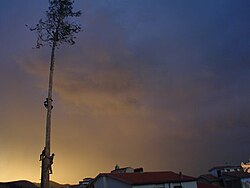Accettura
| Accettura | ||
|---|---|---|
| Comune | ||
| Comune di Accettura | ||

Accettura May Festival
|
||
|
||
| Location of Accettura in Italy | ||
| Coordinates: 40°29′N 16°09′E / 40.483°N 16.150°ECoordinates: 40°29′N 16°09′E / 40.483°N 16.150°E | ||
| Country | Italy | |
| Region | Basilicata | |
| Province / Metropolitan city | Matera (MT) | |
| Area | ||
| • Total | 89 km2 (34 sq mi) | |
| Elevation | 770 m (2,530 ft) | |
| Population | ||
| • Total | 2,427 | |
| • Density | 27/km2 (71/sq mi) | |
| Demonym(s) | Accetturesi | |
| Time zone | CET (UTC+1) | |
| • Summer (DST) | CEST (UTC+2) | |
| Postal code | 75011 | |
| Dialing code | 0835 | |
| Website | Official website | |
Accettura is a town and comune in the province of Matera, in the Southern Italian region of Basilicata. It is bounded by the comuni (Municipalities) of Calciano, Campomaggiore, Cirigliano, Oliveto Lucano, Pietrapertosa, San Mauro Forte and Stigliano.
The territory is half covered by forests and pastures. Around the commune there are the mountains Manche, Gallipoli, Montepiano, Vallefredda and Tempacortaglie. Accettura is 770 metres (2,530 ft) above sea level and is bordered to the north with the comunes of Campomaggiore and Calciano, to the east with Oliveto Lucano and San Mauro Forte, to the south with Stigliano and Cirigliano, and to the west with Pietrapertosa (PZ).
The term, according to some, is derived from the theme of the word "acceptor", which in Latin is Accipiter. For others, it stems from the symbol of the country, to accept a small plot of land, etc.
The first official mention of Accettura in documents was by Pope Nicholas II in 1060, who sent a document sent to the bishop of Tricarico, referring to it as "Achitorem".
Situated in the Appennino Lucano in the Gallipoli-Cognato Park, was founded in the 10th century after the local population had abandoned three neighbouring villages. Nowadays the population work mainly in agriculture, stock-breeding and tourism.
In the tenth century was a feudal territory of Montescaglioso. In 1272, the town was completely destroyed by fire. Shortly after, Charles I of Anjou ordered its reconstruction.
Throughout its history, Accettura was owned by several families: Bazzano, Della Marra, the Ponsiaco, the Carafa, and the Spinelli who held it until the late nineteenth century.
Montepiano woods cover the territory of four communes in this region of Italy, Accettura, Cirigliano, Stigliano and Pietrapertosa. Inside were found numerous remains of fortifications, some of them as old as the third of fourth century BC.
...
Wikipedia


